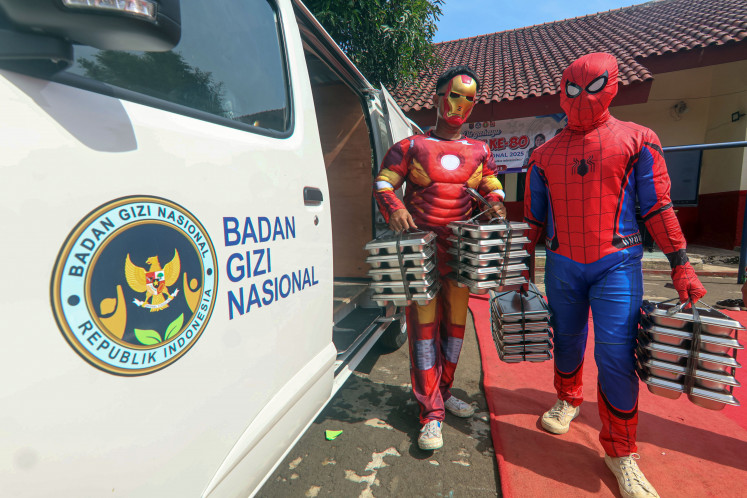Popular Reads
Top Results
Can't find what you're looking for?
View all search resultsPopular Reads
Top Results
Can't find what you're looking for?
View all search results'Memikirkan Kata' deciphers one of the greatest writing conundrums: Producing words
I prefer to call Memikirkan Kata a ‘lesson-learned aspects of writing’ book instead of a technical guide.
Change text size
Gift Premium Articles
to Anyone
O
ne day, Indonesian writer Dewi "Dee" Lestari posted on Instagram a picture of books on story crafting she was reading. The post proves to me one thing: Writing is indeed laborious, yet it is rewarding. While Dee never fails to amaze us with her fantastic, out-of-this-world books, a productive writer like her still feeds her mind and sharpens her skills through theories on writing. Thus, I try to invest in good writing books to learn about the concepts and experiences that shape one as a prolific writer.
Memikirkan Kata: Panduan Menulis Untuk Semua (Contemplating Words: A Writing Guide for Everyone), published by Galeri Buku Jakarta in August, is one of my ultimate picks. Adorned with photographs of legendary authors like Virginia Woolf and Gabriel Garcia Marquez on colorful pages that are truly a feast for the eyes, the book accentuates critical aspects aspiring writers may need in their writing journey. Instead of a mere guide on how to write, the book serves as a compendium of world-famous and Indonesian authors' stories, unfolding the art of composing writings in its multi-layered dimensions.
The book begins by inviting its reader to dig deeper into involving senses in our writing routine. As words are the building blocks of our writing and the product of our thoughts, they require a mental process to ignite the production. Hence, the early chapters encourage us to “listen and read more” to make the writing process a bodily experience before swiftly moving to “more workable writing procedures” in the subsequent section of the book: Natalie Goldberg’s technique in “Kaidah Praktik Menulis” (The Principles of Writing), for instance. In this part, Goldberg demonstrates her approach that mainly centers on self-discipline and the importance of specificity in describing nuances in our fiction. As for non-fiction, like essays, the book provides a thinking guide that may direct us to produce the needed ideas.
In other chapters, though, the composition comprises miniature autobiographies of authors that make up the greater portion of the entire book. While other writing books only focus on an author’s life, Memikirkan Kata offers experiences from many famous authors, such as Haruki Murakami, Kurt Vonnegut and Orhan Pamuk, as well as Indonesian authors like Joko Pinurbo, W.S. Rendra, Intan Paramaditha and Alfrizal Malna.
These narrations prove that rejection, desperation and strenuous effort have become the norm in writing. It took months for Gabriel Garcia Marquez and Philip Roth to write the introductory paragraphs, as shown in “Yang Paling Susah adalah Paragraf Pertama” (The First Paragraph is The Hardest) and “Kalimat Pertama Novel Butuh Perjuangan” (The Struggle of the First Sentence). Stanley Kunitz in “Puisi Sempurna di Kepala, Bahasa Merusaknya” (My Poem is Perfect in My Head, Until Language Ruins It) found that converting ideas to language is extremely difficult as we have to find the right rhythm. To overcome such hardship, Joan Didion in “Cara Terbaik agar Tidak Gagal Menulis Novel” (The Best Way to Avoid Failure Writing A Novel) dismissed the "perfect writing" notion and let herself improve throughout her writing journey. Haruki Murakami in “The Interview: Saya Kurang Suka dengan Gaya Kepenulisan Realis” (The Interview: I Don't Like Realistic Writing Style), similarly, used a unique approach in his creative writing process by deciding the ending as he writes to advance his storyline.
Another think that makes this book worth buying is its diverse explorations on what constitutes the writing world. Curious about the editing and publishing milieu? The chapter “Voice of Editor: Menilik Dapur Pikiran Para Editor Tentang Dunia Kepengarangan” (Voice of Editor: What Editors Think of the Writing World) may feed your curiosity, as it features advice, rules and demands from established editors around the world. Facing writer’s block and finding it hard to produce ideas? We may be inspired from what legendary authors did, as described in “Inspirasi: Bagaimana Ide Bekerja-Dari Saul Hingga Gabriel Marquez” (Inspiration: How Idea Works -- From Saul to Gabriel Marquez) or “Artist at Work: Bagaimana Para Pengarang itu Begitu Keras Bekerja” (Artist at Work: How Writers Struggle). The book even explores the less-talked-about contemporary genres like ‘how-to’ articles, book reviews and online articles in “Writing Tips: Menulis itu Terkadang Mudah” (Writing Tips: Writing is Easy Sometimes).
Personally, “Buku-buku Bagus Tidak Ditulis, Tetapi Ditulis Ulang” (Great Book Are Not Written, But Rewritten) remains one of my favorite chapters. This part endorses the concept of “so what” thinking in writing the early chapters. I find this framework applicable in writing classes that I have been teaching. When teaching students to generate ideas and sustain their reasons, I encourage them to adopt a "so-what" approach to keep their ideas flowing. Applying the "so what" framework reinforces the urgency of our writing, why our ideas matter. I also found that "so what" prevents us from repeating the same idea, leading us to better progression in our writing, which may work in both fiction or non-fiction.
Additionally, we can learn a thing or two from what Silviana Paternoso experienced when joining one of Gabriel Garcia Marquez’s workshops. Marquez emphasized the importance of literary elements in journalism--one of the most important yet overlooked elements in news coverage. He also highlighted what makes good reporting by relying on our senses. He harbored doubts about the use of a tape recorder and recommended our direct observation instead when collecting information.
Briefly put, Memikirkan Kata indeed lives up to its name. Producing words often leads us to the dark abyss and an endless loop of uncertainty. We fear what our readers may perceive in our writing. The book, nevertheless, tries to acknowledge this collective fear and restore our confidence by narrating the same arduous process that those acclaimed authors had experienced. All of these writers’ accounts are effortless to comprehend thanks to the authors and translators, who exerted great effort in arranging such pleasant reads. I prefer to call this a ‘lesson-learned aspects of writing’ book instead of a technical guide. Thus, I recommend this 500ish-page book wholeheartedly. Devour it slowly and take it as a mental tour of the world’s brightest minds. (wng)
***
Nindya Soraya Dharma is an English Instructor at Balai Bahasa, Indonesian University of Education (UPI), Bandung. In her spare time, she writes, reads and plays games. Her blogs: https://medium.com/@nindyasoraya and https://nsdreads.wordpress.com/











